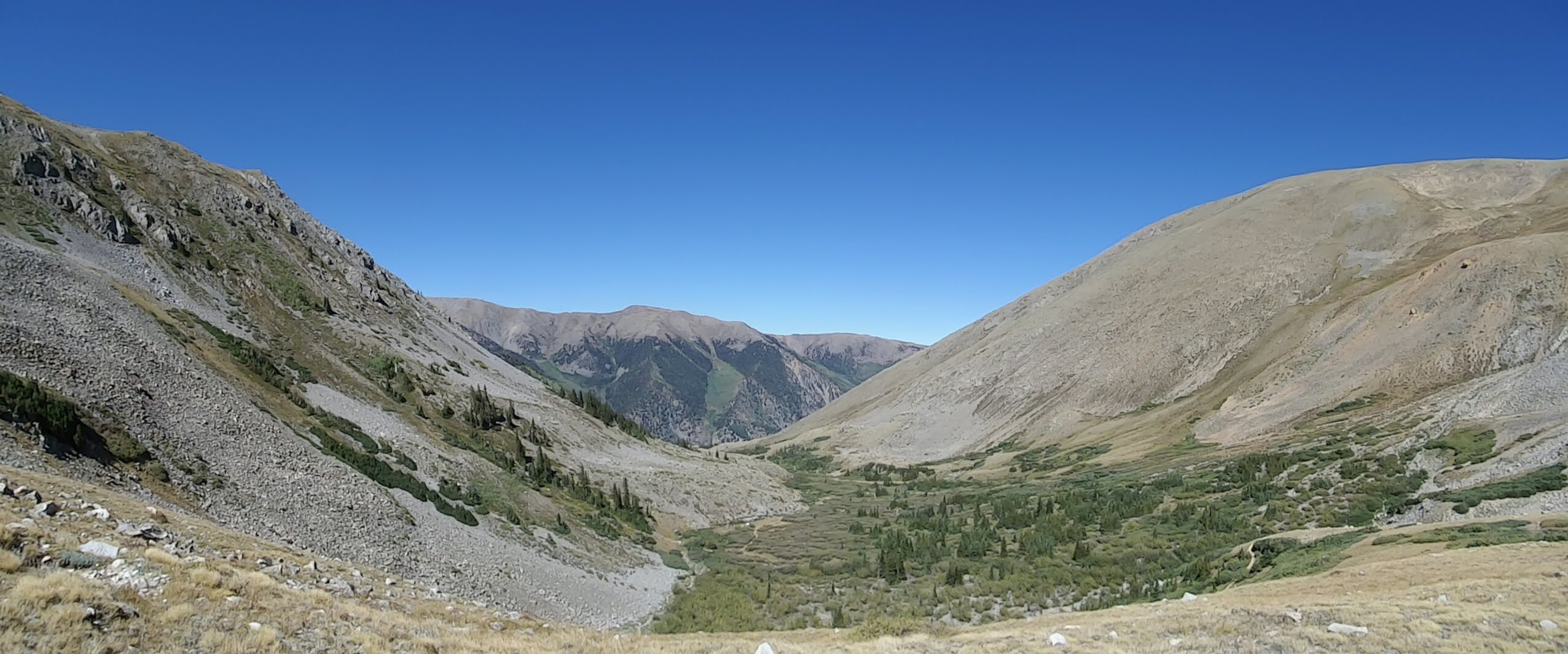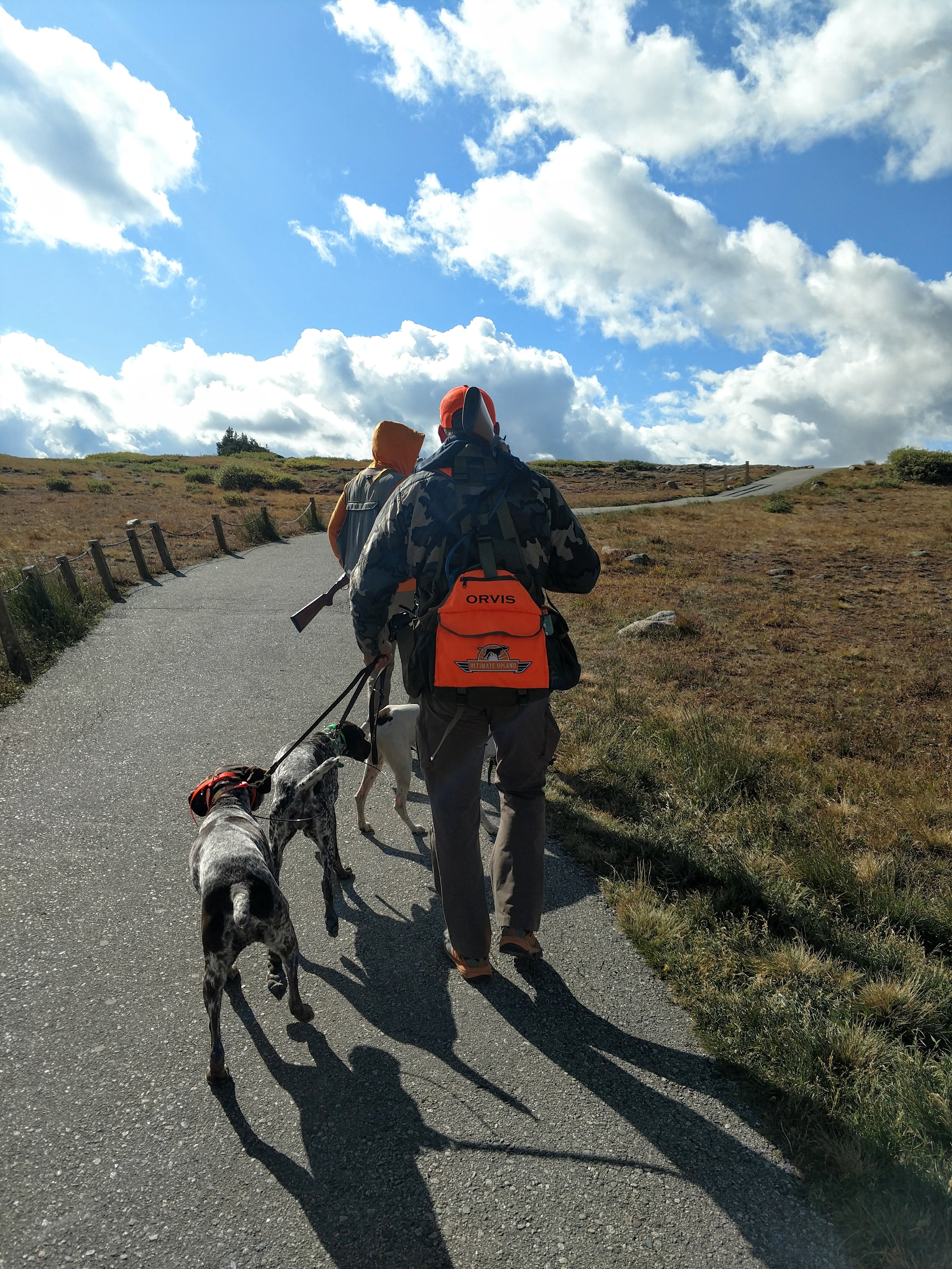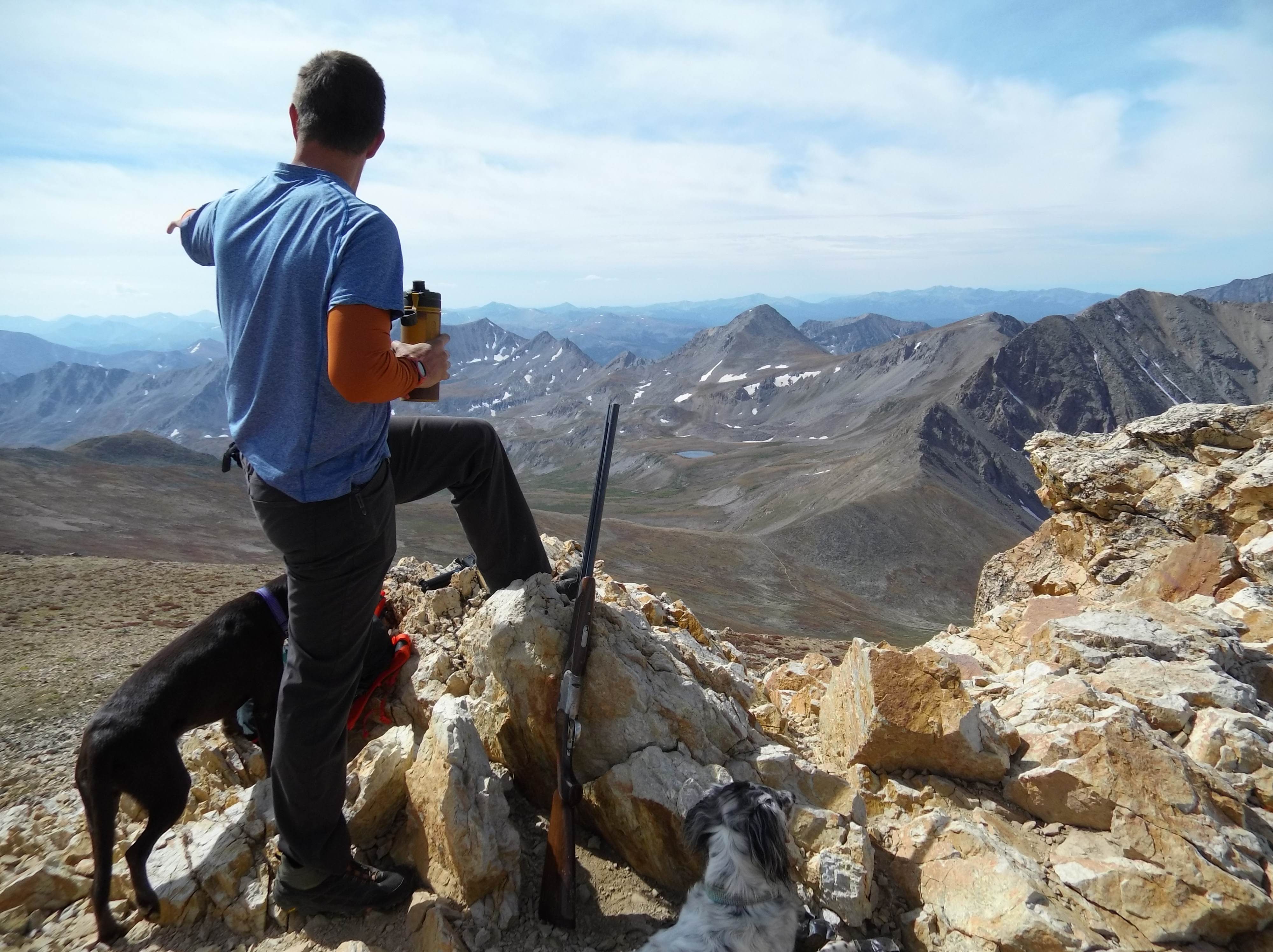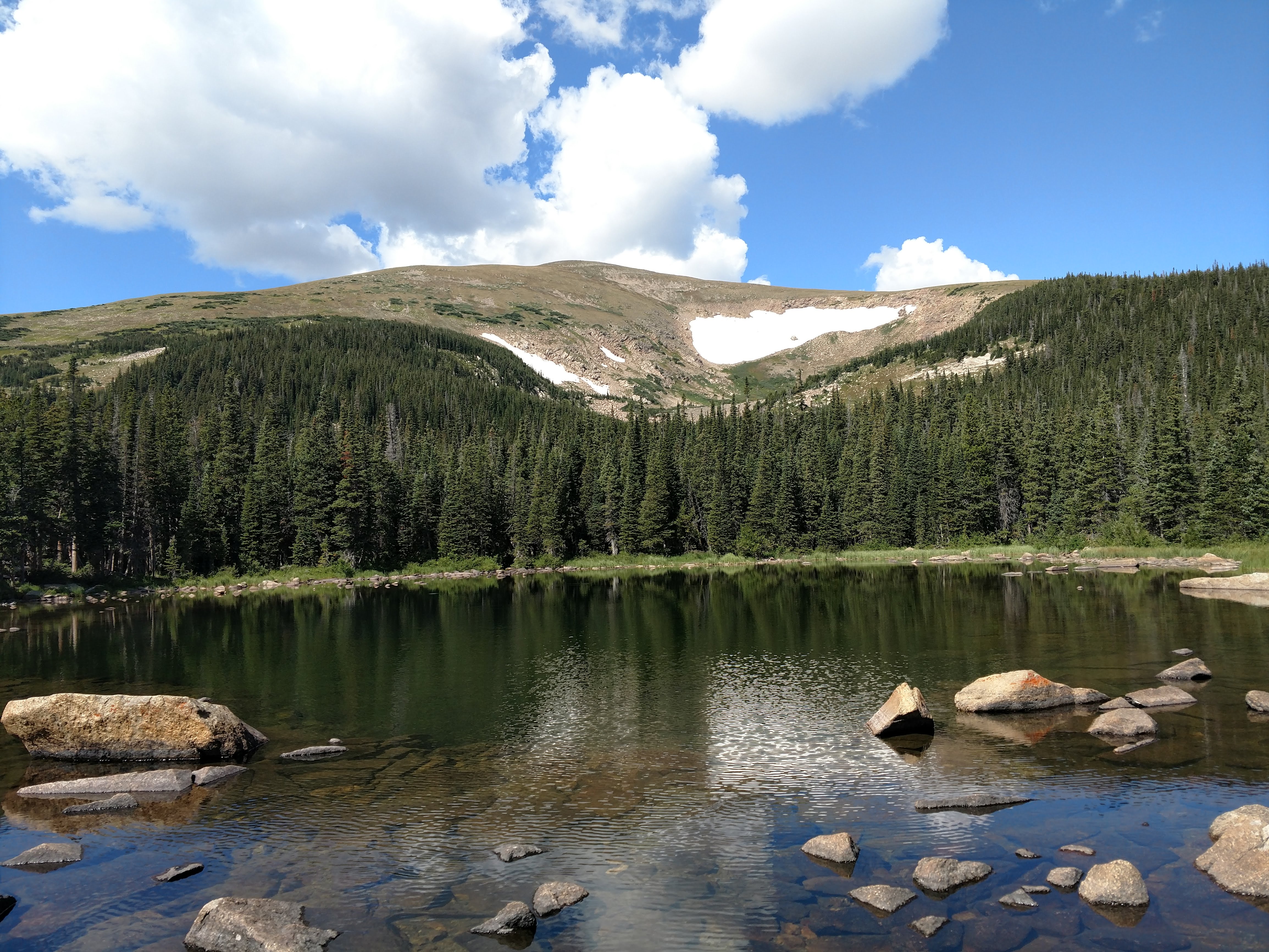Pre-dawn
It was still dark when We pulled into the trailhead. Clad in technical hunting gear with heavy packs and antsy bird dogs in the back of the pickups. Really the only reason we were so early was to get a choice spot in the parking lot. We were waiting for daylight so that we could hunt up the mountain. Trail runners, through hikers, day hikers, and others filed by. A couple of hikers made pancakes next to the Forest Service rest rooms, of the buttermilk and blueberry variety. We clearly weren’t the only ones in a questionable mental state.

We were about to enter the Collegiate Peaks Wilderness Area for the next day and a half, the goal was to hunt Colorado’s blue grouse and white-tailed ptarmigan. You can find the two birds in pockets of habitat and often are only found with miles and miles of walking. Blue grouse migrate uphill with the season, snow pushing them up from the sagebrush transition zone to the spruce forests at high elevation. Ptarmigan relish the rocky crags of Colorado’s high peaks favoring moths and buds, and leaves among boulder fields at treeline.
We set our sights on a popular trail towards a trio of Colorado’s 14,000ft peaks. We were the only hunters perhaps crazy enough to do it this week, and probably this season. Wilderness hunting is all the rage for big game hunters targeting elk or mule deer, but they often focus on less traveled areas. Elevation is key to elk hunting, but rarely are elk at the top of a fourteener.
Brand Ambassadors
The trail was busy, and being the only crew of hunters on the mountains that day gave us a lot of exposure. Bird dogs circling, me in the back of the pack of bipeds puffing from six weeks of couch-bound paternity leave. I used every excuse to stop and chat with folks along the trail. Looks from the passersby ranged from genuine curiosity to downright disdain.
What became clear pretty soon was that our purpose was unclear, at least to the casual observer. We bore the heavy loads of an overnight pack, stuffed to the gills, we carried shotguns, all of us had our SOS beacons hanging from packs or belt loops. It seemed so obvious to us, we were loaded up for some backcountry bird hunting. To others, we were just three guys with dogs and guns.
So what can you do? Despite what social media might have you believe the number of active hunters in the United States is gradually decreasing as people age out of the sport. The best thing you can do is be polite and engaging. You have every right to be on the mountain as your fellow peak baggers.
The best ambassadors we have as bird hunters are our dogs. Rio the English Setter, Ida the Chocolate Lab, Charlie and Libby the German Shorthairs were recognizable all over the mountain and in the valley. The dogs make us more amicable to the casual observer, and your relationship with your dog can easily be seen from afar on these peaks.
We greeted nearly everyone, every encounter a chance to discuss what we were up to, and what we were in search of. Breaking open our shotguns was the easiest way to making ourselves approachable. Carrying at port arms is a good way to look menacing to someone who might otherwise be curious. Many folks were receptive, if a little taken aback that you could hunt on this trail. What many didn’t realize was that this was land managed by the US Forest Service, land managed for multiple use. Just because the predominant users of this trail were hikers didn’t mean they were the only ones.
Multiple Use
The US Forest Service manages much of the land in Colorado through both the National Forests, National Grasslands, and federally designated Wilderness Areas. That land, since 1960 has to be managed under the Multiple Use and Sustained Yield Act. Briefly that means that the resources need to be managed for multiple land users and resource yield providing some form of income. Uses of the land are generally balanced, but they can have some restrictions placed on them. Designating land as a Federal Wilderness area for instance, like Collegiate Peaks, forbids the use of mechanical conveyances and also protects the wilderness against extractive leasing such as oil and gas wells being placed on the property.

The use across land holdings by the US Forest Service is balanced between users. Extractive mining, Logging, Ski Resorts all have paid leases. Hunters and anglers pay their share through license fees and the Pittman-Robertson taxes they pay on their gear. Offroaders pay through Off-Highway Vehicle registration fees. Other users of the resources are hikers, mountain bikers, and climbers among any other activities you can dream up.

Hunters may think they own the woods during the fall but with the declining hunter numbers and the surge towards outdoor meccas such as Denver means that we’re far from the only outdoor users on these trails. Keeping up good relationships with other users of the same resources is key to having a continued voice at the table for management of the resources. If it weren’t for several hikers on the trail, I wouldn’t have a bunch of new intel for future ptarmigan hunting.
First Contact
“Rio’s got a solid point!” Brian yelled from down the hill. My lungs were already burning; I was already pretty well wiped out. The thought of birds on the mountain invigorated me into closing the distance. Hikers were coming up behind me, and already well ahead of me as I worked my way up to where the dogs were. I struggled for a bit trying to search for the bird. Then I realized this small grey and white rock more or less in front of me was a white-tailed ptarmigan. Brian was perched above me some 30 feet on the next switchback in the trail directing me towards the bird. I walked in on it, but it refused to move. I got to within a distance of about two arm lengths when I realized the optics of the situation.
If I shot this bird on the ground, not only would I have ground ptarmigan… ptar-ptar as it were, but I’d be violating wingshooting ethics and ground swatting a bird. I also had an audience of non-hunters, perhaps the first bird hunter many of them had ever seen. What image would I present as a person who would shoot a bird no bigger than a Nerf Football at close range simply to check a species off of my list?
A nearby hiker, seemingly seeing my dilemma shouted “Throw a rock at it!” In some places sticks and stones are legal methods of take for ptarmigan. In Colorado you can take them legally with an air pistol, slingshot, pistol, or rifle in addition to the traditional shotgun. Ptarmigan aren’t used to seeing humans or canines as pressure in their natural environment. People pass by these birds in the high country every single day without even knowing that they exist.
Sticks and Stones
Had I picked up a rock, I’d likely have killed the bird with it. Rather than attempting to flush it, I declined and watched the bird a short while. Had I done so the bird likely would have flown only a short distance to land among the grey-white rocks. If I’d then killed the bird, I would have taken my first ptarmigan with a rock. That’s a dubious distinction. Like taking your first grouse along a road feeding for gravel. It’s a story that would unlikely ever be told at hunting camp. Much less an appealing story for those around me.
While I don’t much care what other people think of me, I do care what others think about hunters in general. It was evident on the mountain that our group with our bird dogs and shotguns were in the smallest of minorities. The Collegiate Peaks Wilderness Area is a subset of San Isabelle National Forest, designated by Congress in 1980 in order to keep the area pristine from development. In an area that’s two and a half hours from the Denver Metro area it draws thousands of people per year to hike the eight 14,000ft peaks.
I flushed the bird again and didn’t take a shot. Rio ran down and attempted to point the bird again and again but it wasn’t a shot worth taking. It was a juvenile bird uneducated to the ways of dogs and hunters and by now the wary hikers below were closing the distance. We recalled the dogs and pressed onward up the mountain towards the summit.
On the Summit of Belford

The experience on the front face of Mount Belford was one that could have changed the way I was perceived as a hunter. However, the scene from the summit was one that I will remember forever.
I summited that mountain, but not without the encouragement of my fellow hunter on the trip Brian and from my fellow hikers. It’s only the second 14,000 foot summit I’ve hiked to besides Mt. Evans. None of them are easy.
However, something happened on that summit that I can say for certain very few bird hunters have had the opportunity to do. That moment helped define who I am, and how the world sees me as a hunter. Surrounded by folks taking selfies with cardboard signs recording their achievements I was able to take a shot at my first wild ptarmigan. From the summit of Mt. Belford. How did it end? Well, you could say that story is still unfolding. I still have many more mountains to climb, more bird dogs to follow, and more double guns to fawn over. The rest of the Mount Belford trip you’ll see in October on Ultimate Upland.
| Why am I doing this? I’m on a quest to hike, camp, hunt, or fish on all of Colorado’s federally designated Wilderness Areas. Check out all the articles here! |




[…] « Previous Story […]